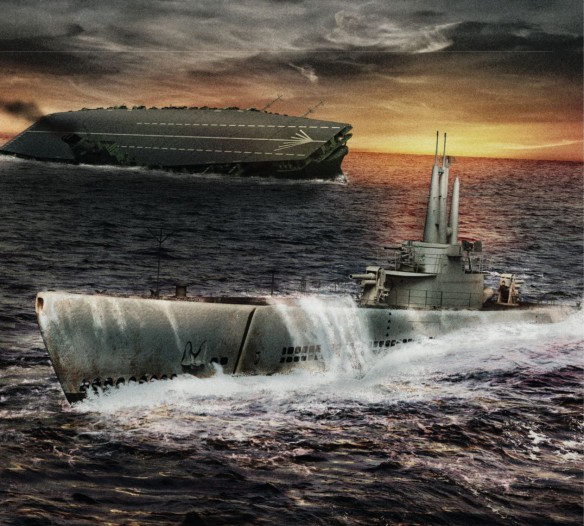
On November 24 and 27 1944, over a hundred B-29 Superfortresses based at the newly completed airfield in the Marianas made their first two bombing runs over the Japanese mainland. Patrolling off Tokyo Bay, Frederick Gunn, commanding Scabbardfish, and Joseph Enright, commanding Archerfish, were ordered to lifeguard for these attacks. As it turned out, neither was called upon for rescues, and both boats were subsequently released to conduct regular antishipping patrols in the immediate area off Tokyo Bay. Gunn on Scabbardfish sank a Japanese submarine, I-365, 1,500 tons, almost immediately. For Enright there was bigger game.
It was Enright who had made the first patrol on Dace and then asked to be relieved because he had no confidence in himself. He had come to Archerfish after nearly a year of shore duty. Now, on the night of November 28, Enright made contact with Shinano, brand new sister ship of Yamato and Musashi, which had been converted to an aircraft carrier while still being built. Her conversion being almost finished, she had been hurriedly commissioned on November 18, with Captain Toshio Abe in command, and was getting her finishing touches in Tokyo Bay when the B-29 raids began. Though these initial raids did relatively little damage, they made the Japanese uneasy. On November 28 Shinano got under way under orders from Imperial Naval Headquarters that she be moved out of the bay to the relatively safer waters of the Inland Sea. Four destroyers escorted her.
Structurally, Shinano was finished, but many details, such as fire pumps, were not yet complete. There were 1,900 people on board, some of them crew, others yard workers who would finish the ship, which at 60,000 tons would be the largest warship in the world (slightly larger than Yamato). Many of the crew were green; they had never been to sea. There had been no training.
That night, Joe Enright in Archerfish patrolled the outer entrances to Tokyo Bay. At 8:48, his radar operator reported a pip at 24,700 yards. Fifty-two minutes later, Enright knew he had an aircraft carrier, headed south, speed 20 knots. He laid a course to intercept and called for flank speed. “From here on,” Enright wrote later, “it was a mad race for a possible firing position. His speed was about one knot in excess of our best, but his zig plan allowed us to pull ahead very slowly.”
Enright thought he was losing the race and sent off two contact reports to Lockwood, so that he could alert submarines to the south. But then at 3 A.M.-about six hours after the chase began-the carrier changed course and headed right for Archerfish. Enright submerged ahead. The huge ship came onward while Enright’s crew made everything ready.
At 3: 16 A.M. 29 November, Enright began firing his bow tubes from a range of about 1,500 yards. Sigmund Albert (“Bobo”) Bobczynski, his exec, was watching the TDC, holding his breath. After four torpedoes had left the tubes, he shouted, “Check fire! New setup. Switch to stem tubes.” Then Enright fired two stem tubes.
Forty-seven seconds after the first torpedo was fired, Enright, manning the periscope, saw and heard a hit in the carrier’s stern. “Large ball of fire climbed his side,” Enright noted. Ten seconds later, he saw a second hit, 50 yards forward of the first.
There was a destroyer only 500 yards on Archerfish’s quarter. Enright went deep. On the way down, he said later, he heard four more properly timed hits, indicating all six of his torpedoes had hit Shinano. Sonar reported breaking-up noises. The escorts dropped fourteen depth charges, the nearest, Enright reported, 300 yards distant. When that noise died away, the sonarman reported more breaking- up noises. The heavy screw noise of the carrier could not be heard.
At 6: 10, Enright returned to the surface for a look through the periscope. “Nothing in sight,” he reported. He was certain that the carrier went down on the spot.
After the war, the records revealed that Shinano took four hits. Captain Abe was not overly concerned; the sister ship, Musashi, had taken nineteen torpedoes and many bombs before sinking at Leyte. He continued on his course at 18 knots. His inexperienced damage control parties tried to stop the flow of water, but they fought a losing battle. It was discovered that Shinano did not have all her watertight doors, and some that were in place leaked. Captain Abe could have grounded Shinano in shallow water and saved her, but he continued on. By dawn, it was evident to all that she was sinking. At 10: 18, Abe ordered abandon ship. Half an hour later, the world’s largest warship slid beneath the waves, taking down Abe and 500 men.
Enright remained on station another two weeks, lifeguarding B-29 raids. He received two calls for help but could never find the downed pilots. On December 9, another off day, he fired four torpedoes at two small patrol boats and missed. He returned Archerfish to Guam December 15, claiming to have sunk a Hayatake-class carrier of 28,000 tons.
Some people were naturally skeptical. The codebreakers believed they had identified all the remaining Japanese carriers and knew where they were. But Enright’s division commander, Burt Klakring, submitted a drawing of the carrier composed by Enright, and Babe Brown, acting in Lockwood’s absence, credited him with sinking a 28,000-ton carrier. It was not until after the war that the whole story of Shinano, converted in secret and unknown to the codebreakers, came out. Then the tonnage was upped to 71,000 and Enright received a Navy Cross.
The unlikely Joe Enright, a cautious and uncertain skipper, had by the luck of the draw sunk the largest warship in history and the largest ship ever sunk by a submarine. Although in the postwar accounting the tonnage was reduced to 59,000, from a tonnage standpoint Enright’s first patrol on Archerfish was still the best of the war.